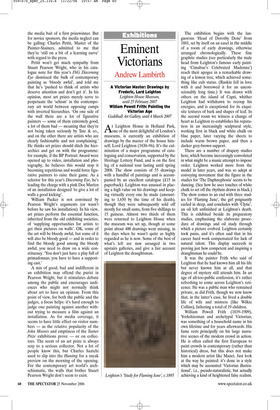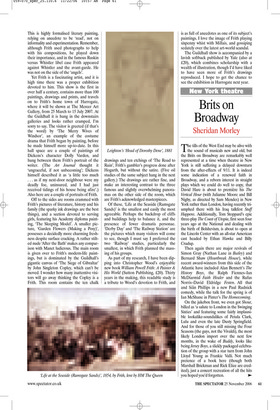Eminent Victorians
Andrew Lambirth
A Victorian Master: Drawings by Frederic, Lord Leighton Leighton House Museum, until 25 February 2007 William Powell Frith: Painting the Victorian Age Guildhall Art Gallery, until 4 March 2007
At Leighton House in Holland Park, one of the most delightful of LondonŌĆÖs museums, is currently an exhibition of drawings by the master of the house himself, Lord Leighton (1830ŌĆō96). ItŌĆÖs the culmination of a major programme of cataloguing and conservation, supported by the Heritage Lottery Fund, and is on the first leg of a national tour lasting until spring 2008. The show consists of 55 drawings with a handful of paintings and is accompanied by an excellent catalogue (┬Ż15 in paperback). Leighton was unusual in placing a high value on his drawings and keeping virtually every one he made (amounting to 1,650 by the time of his death), though they were subsequently sold off mostly for small sums, from five shillings to 15 guineas. Almost two thirds of them were returned to Leighton House when the museum was set up, though at some point about 400 drawings went missing, in the days when he wasnŌĆÖt quite as highly regarded as he is now. Some of the best of whatŌĆÖs left are now arranged in two upstairs galleries, and give a fair account of Leighton the draughtsman. The exhibition begins with the languorous ŌĆśHead of Dorothy DeneŌĆÖ from 1881, set by itself on an easel in the middle of a room of early drawings, otherwise arranged chronologically. These fine graphite studies (see particularly the male head from LeightonŌĆÖs famous early painting ŌĆśCimabueŌĆÖs Celebrated MadonnaŌĆÖ) reach their apogee in a remarkable drawing of a lemon tree, which achieved something like cult status. (Ruskin fell in love with it and borrowed it for an unconscionably long time.) It was drawn with others on the island of Capri, whither Leighton had withdrawn to recoup his energies, and is exceptional for its exquisite textures of bark and shapes of leaf. In the second room we witness a change of heart as Leighton re-establishes his reputation in an increasingly sculptural style, working first in black and white chalk on blue paper, later varying the sheets to include warm brown paper, and then a darker grey-brown support.
There are a number of drapery studies here, which become increasingly convoluted in what might be a manic attempt to impose order. Leighton worked more from the model in later years, and was so adept at conveying movement that the figure in the studies for ŌĆśThe DaphnephoriaŌĆÖ seems to be dancing. (See how he uses touches of white chalk to set off the rhythms drawn in black.) The show comes to an end with three studies for ŌĆśFlaming JuneŌĆÖ, the girl poignantly curled in sleep, and concludes with ŌĆśClytieŌĆÖ, an oil left unfinished at LeightonŌĆÖs death. This is exhibited beside its preparatory studies, emphasising the elaborate procedure of drawings and oil study through which a picture evolved. Leighton certainly took pains, and itŌĆÖs often said that in his career hard work compensated for lack of natural talent. This display succeeds in proving just how competent and inspiring a draughtsman he could be.
It was the painter Frith who said of Leighton that he had known him all his life but never known him at all, and that degree of mystery still attends him. In an age of all-too-public confession, itŌĆÖs rather refreshing to come across LeightonŌĆÖs reticence. He was a public man who remained private, as did Frith, though we now know that, in the latterŌĆÖs case, he lived a double life of wife and mistress (like Wilkie Collins), fathering a total of 19 children.
William Powell Frith (1819ŌĆō1909), Yorkshireman and archetypal Victorian, was something of a household name in his own lifetime and for years afterwards. His fame rests principally on his large narrative scenes of the modern crowd in action. He is often called the first European to paint crowds in contemporary (rather than historical) dress, but this does not make him a modern artist like Manet. Just look at the way he painted: itŌĆÖs done in a style which may be accounted ŌĆśVictorian illustrationalŌĆÖ, i.e., pseudo-naturalistic, but actually achieving a kind of heightened false realism. This is highly formalised literary painting, relying on anecdote to be ŌĆśreadŌĆÖ, not on informality and experimentation. Remember, although Frith used photographs to help with his compositions, he played down their importance, and in the famous Ruskin versus Whistler libel case Frith appeared against Whistler and the avant-garde. He was not on the side of the ŌĆśangelsŌĆÖ.
Yet Frith is a fascinating artist, and it is high time there was a proper exhibition devoted to him. This show is the first in over half a century, contains more than 100 paintings, drawings and prints, and travels on to FrithŌĆÖs home town of Harrogate, where it will be shown at The Mercer Art Gallery, from 25 March to 15 July 2007. At the Guildhall it is hung in the downstairs galleries and looks rather cramped, IŌĆÖm sorry to say. The visitor is greeted (if thatŌĆÖs the word) by ŌĆśThe Merry Wives of WindsorŌĆÖ, an example of the costume drama that Frith began by painting, before he made himself more up-to-date. In this hall space are a couple of paintings of DickensŌĆÖs character Dolly Varden, and hung between them FrithŌĆÖs portrait of the writer. (The Art Journal thought it ŌĆśungraceful, if not unbecomingŌĆÖ; Dickens himself described it as ŌĆśa little too much ... as if my next-door neighbour were my deadly foe, uninsured, and I had just received tidings of his house being afireŌĆÖ.) Also here are a couple of portraits of Frith.
Off to the sides are rooms crammed with FrithŌĆÖs pictures of literature, history and his family (the sparky ink drawings are the best things), and a section devoted to serving girls, featuring his Academy diploma painting, ŌĆśThe Sleeping ModelŌĆÖ. A smaller picture, ŌĆśGarden Flowers (Making a Posy)ŌĆÖ, possesses a decidedly more charming freshness despite surface cracking. A rather stilted nude ŌĆśAfter the BathŌĆÖ makes any comparison with Manet ludicrous. The main room is given over to FrithŌĆÖs modern-life paintings, but is dominated by the GuildhallŌĆÖs gigantic canvas of ŌĆśThe Siege of GibraltarŌĆÖ by John Singleton Copley, which canŌĆÖt be moved. I wonder how many inattentive visitors will go away thinking the Copley is a Frith. This room contains the ten chalk drawings and ten etchings of ŌĆśThe Road to RuinŌĆÖ, FrithŌĆÖs gamblerŌĆÖs progress done after Hogarth, but without the satire. (Five oil studies of the same subject hang in the next gallery.) The drawings are rather fine, and make an interesting contrast to the three famous and slightly overwhelming panoramas on the other side of the room, which are FrithŌĆÖs acknowledged masterpieces.
Of these, ŌĆśLife at the Seaside (Ramsgate Sands)ŌĆÖ is the smallest and easily the most agreeable. Perhaps the backdrop of cliffs and buildings help to balance it, and the presence of fewer dramatis personae. ŌĆśDerby DayŌĆÖ and ŌĆśThe Railway StationŌĆÖ are the pictures which many visitors will come to see, though I must say I preferred the two ŌĆśRailwayŌĆÖ studies, particularly the smallest, in which Frith planned the massing of his groups.
As part of my research, I have been dipping into Christopher WoodŌĆÖs enjoyable new book William Powell Frith: A Painter & His World (Sutton Publishing, ┬Ż20). Thirty years in the making, this readable study is a tribute to WoodŌĆÖs devotion to Frith, and is as full of anecdotes as one of its subjectŌĆÖs paintings. I love the image of Frith playing sixpenny whist with Millais, and gossiping sedately over the latest art-world scandal.
The Guildhall show is accompanied by a lavish softback published by Yale (also at ┬Ż20), which combines scholarship with a wealth of illustration, though IŌĆÖd have liked to have seen more of FrithŌĆÖs drawings reproduced. I hope to get the chance to see the exhibition in Harrogate next year.



























































































 Previous page
Previous page